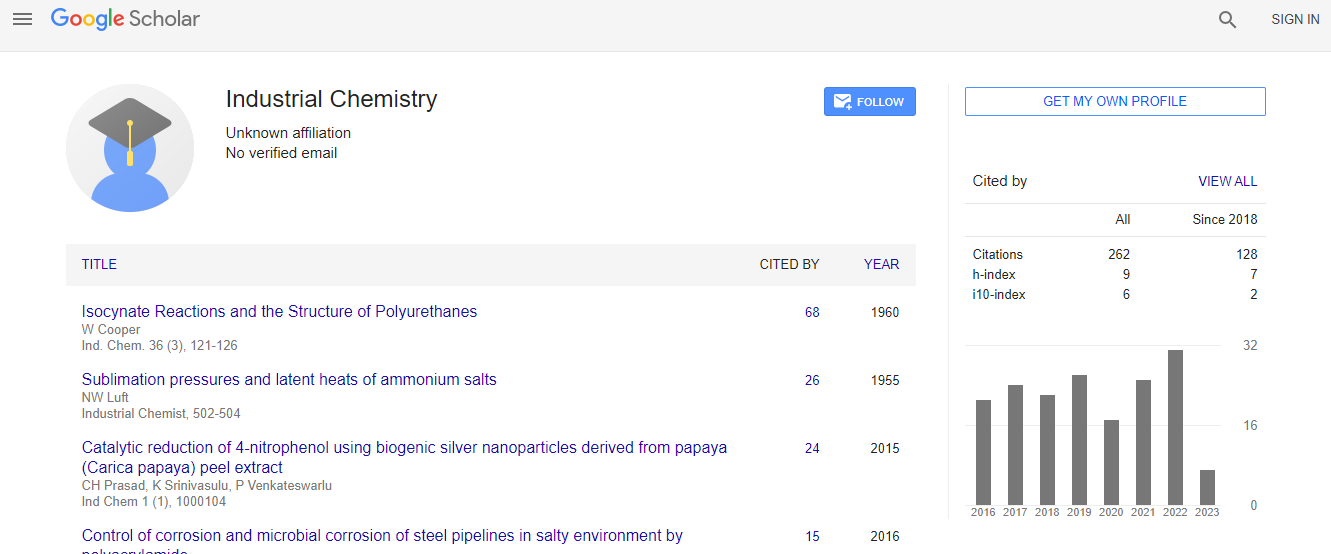Our Group organises 3000+ Global Conferenceseries Events every year across USA, Europe & Asia with support from 1000 more scientific Societies and Publishes 700+ Open Access Journals which contains over 50000 eminent personalities, reputed scientists as editorial board members.
Open Access Journals gaining more Readers and Citations
700 Journals and 15,000,000 Readers Each Journal is getting 25,000+ Readers
Google Scholar citation report
Citations : 262
Industrial Chemistry received 262 citations as per Google Scholar report
Indexed In
- Index Copernicus
- Google Scholar
- RefSeek
- Directory of Research Journal Indexing (DRJI)
- Hamdard University
- EBSCO A-Z
- OCLC- WorldCat
- Scholarsteer
- Geneva Foundation for Medical Education and Research
- Euro Pub
Useful Links
Recommended Journals
Related Subjects
Share This Page
Functionalized gold nanoparticles based colorimetric sensors for heavy metal ions from waste water
2nd World Conference on Industrial Chemistry and Water Treatment
Palash Mondal and Jeffery L Yarger
Arizona State University, USA Vivekananda Mahavidyalaya, India
ScientificTracks Abstracts: Ind Chem
Abstract
Contamination of water by heavy or toxic metal ions can lead to serious environmental and human health problems. There are several toxic metal ions (e.g., mercury, cadmium and lead) can cause serious environmental and human health problems because of their acute and chronic toxicity to biological system. For example, the most common form of mercury in water is mercuric ion (Hg2+) which is widely released to the environment from industrial source, shows high toxicity mainly on renal and nervous systems through the disruption of enzyme activity. On the other hand, lead ions (Pb2+) released to the environment through dyes, gasoline and batteries and it can cause neurological, cardiovascular and developmental disorders in especially children. Another highly toxic metal ion is cadmium (Cd2+), found in many end user products such as plastics, batteries, cigarettes and dyes. Therefore, monitoring of toxic metal ions in water (drinking, sea, lake, etc.) is very essential in terms of improving human health and water quality. There are several methods used for heavy or toxic metal ion detection which is often based on chromatographic and spectroscopic techniques such as inductively coupled plasma mass spectrometry (ICP-MS), atomic absorption spectrometry (AAS), high performance liquid chromatography (HPLC) and electrochemistry. Although these methods are highly sensitive and selective, they require high sophisticated instruments, are expensive, timeconsuming and non-portable. Therefore, low cost, simple, rapid, portable and green methods for metal ion detection are still highly desired. In this regard, colorimetric methods based on functionalized gold nanoparticles (AuNPs) are convenient and attractive, and can satisfactorily meet these demands. Because AuNPs exhibit high extinction coefficients, strongly distancedependent optical properties, and colors arising from AuNPs at nanomolar concentrations allow them to be easily monitored by the naked eye without the aid of any advanced instruments.Biography
Palash Mondal has completed his PhD from Visva-Bharati University, Santiniketan, India, in 2013. During his PhD study, he focused research on polymer encapsulated nanomaterials for extraction of toxic metal ions from aqueous solution. Currently he is a Post-doctoral Research Scholar at Arizona State University, Arizona, USA. Presently he is working on polymer capped functionalized gold nanoparticles for detection of heavy or toxic metal ions from waste water.
Email: pmondal2@asu.edu

 Spanish
Spanish  Chinese
Chinese  Russian
Russian  German
German  French
French  Japanese
Japanese  Portuguese
Portuguese  Hindi
Hindi 